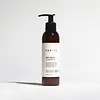What's inside
What's inside
 Key Ingredients
Key Ingredients

 Benefits
Benefits

 Concerns
Concerns

 Ingredients Side-by-side
Ingredients Side-by-side

Plukenetia Volubilis Seed Oil
EmollientAdansonia Digitata Seed Oil
EmollientMoringa Oleifera Seed Oil
EmollientSqualane
EmollientOlea Europaea Fruit Oil
MaskingLimnanthes Alba Seed Oil
Skin ConditioningAleurites Moluccanus Seed Oil
Skin ConditioningSimmondsia Chinensis Seed Oil
EmollientArgania Spinosa Kernel Oil
EmollientOryza Sativa Bran Oil
EmollientCamellia Japonica Seed Oil
EmollientPEG-16 Macadamia Glycerides
EmollientVitis Vinifera Seed Oil
EmollientCitrus Nobilis Oil
MaskingLavandula Angustifolia Oil
MaskingPelargonium Graveolens Oil
MaskingCitrus Limon Peel Oil
MaskingSantalum Spicata Wood Oil
PerfumingChamomilla Recutita Oil
MaskingBoswellia Carterii Oil
MaskingDaucus Carota Sativa Seed Oil
EmollientMentha Viridis Leaf Oil
AstringentTocopherol
AntioxidantTocotrienols
Skin ConditioningPlukenetia Volubilis Seed Oil, Adansonia Digitata Seed Oil, Moringa Oleifera Seed Oil, Squalane, Olea Europaea Fruit Oil, Limnanthes Alba Seed Oil, Aleurites Moluccanus Seed Oil, Simmondsia Chinensis Seed Oil, Argania Spinosa Kernel Oil, Oryza Sativa Bran Oil, Camellia Japonica Seed Oil, PEG-16 Macadamia Glycerides, Vitis Vinifera Seed Oil, Citrus Nobilis Oil, Lavandula Angustifolia Oil, Pelargonium Graveolens Oil, Citrus Limon Peel Oil, Santalum Spicata Wood Oil, Chamomilla Recutita Oil, Boswellia Carterii Oil, Daucus Carota Sativa Seed Oil, Mentha Viridis Leaf Oil, Tocopherol, Tocotrienols
Caprylic/Capric Triglyceride
MaskingPEG-40 Sorbitan Peroleate
EmulsifyingPrunus Armeniaca Kernel Oil
MaskingTocopherol
AntioxidantTocopheryl Acetate
AntioxidantAscorbyl Palmitate
AntioxidantCitrus Aurantium Dulcis Peel Oil
MaskingHelianthus Annuus Seed Oil
EmollientDicaprylyl Carbonate
EmollientBorago Officinalis Seed Oil
EmollientCitrus Paradisi Peel Oil
MaskingCitrus Nobilis Peel Oil
MaskingRosmarinus Officinalis Leaf Extract
AntimicrobialAleurites Moluccanus Seed Oil
Skin ConditioningCymbopogon Citratus Leaf Oil
MaskingLavandula Hybrida Oil
EmollientOryza Sativa Bran Oil
EmollientLavandula Angustifolia Oil
MaskingC12-15 Alkyl Benzoate
AntimicrobialCetyl Ethylhexanoate
EmollientCitral
PerfumingLimonene
PerfumingLinalool
PerfumingCaprylic/Capric Triglyceride, PEG-40 Sorbitan Peroleate, Prunus Armeniaca Kernel Oil, Tocopherol, Tocopheryl Acetate, Ascorbyl Palmitate, Citrus Aurantium Dulcis Peel Oil, Helianthus Annuus Seed Oil, Dicaprylyl Carbonate, Borago Officinalis Seed Oil, Citrus Paradisi Peel Oil, Citrus Nobilis Peel Oil, Rosmarinus Officinalis Leaf Extract, Aleurites Moluccanus Seed Oil, Cymbopogon Citratus Leaf Oil, Lavandula Hybrida Oil, Oryza Sativa Bran Oil, Lavandula Angustifolia Oil, C12-15 Alkyl Benzoate, Cetyl Ethylhexanoate, Citral, Limonene, Linalool
 Reviews
Reviews

Alternatives
Ingredients Explained
These ingredients are found in both products.
Ingredients higher up in an ingredient list are typically present in a larger amount.
Aleurites Moluccanus Seed Oil is oil from the Kukui nut and native to Hawaii.
Aleurites Moluccanus Seed Oil helps soften the skin as an emollient. It also provides antioxidants. Antioxidants help fight free-radicals. Free-radicals are molecules that may damage your skin cells, such as pollution.
Aleurites Moluccanus Seed Oil can also help soothe the skin.
This nut has been used by many cultures for curing illnesses, such as headache and fever.
Learn more about Aleurites Moluccanus Seed OilLavandula Angustifolia Oil is more commonly known as lavender essential oil. It is considered a fragrancing ingredient.
Lavender imparts a famous scent. While the smell is lovely, this ingredient and may sensitize skin in topical products. This is because about 85% of the oil is made up of linalool and linalyl acetate.
When exposed to air, these two compounds become strong allergens. This ingredient exhibits cytotoxicity at low concentrations; amounts of 0.25% have been shown to damage skin cells.
A study from Japan found this ingredient caused lavender sensitivity after widespread exposure.
Lavender essential oil has some antimicrobial, antibacterial, and anti-inflammatory properties. However, the cons of this ingredient may outweight the pros.
More research is needed to confirm lavender essential oil's effects when used in aromatherapy.
Lavandula Angustifolia is known as the English Lavender and famous for creating purple fields in Provence, France.
Learn more about Lavandula Angustifolia OilOryza Sativa Bran Oil comes from the outer layer of a rice kernel. It is a byproduct of milling rice, or the operation to produce a whole grain rice product.
This ingredient has emollient and skin conditioning properties. This is due to its polysaccharides and omega-3 fatty acids.
Emollients help soothe and soften the skin. It does this by creating a protective film on your skin. This barrier helps trap moisture and keeps your skin hydrated.
Learn more about Oryza Sativa Bran OilTocopherol (also known as Vitamin E) is a common antioxidant used to help protect the skin from free-radicals and strengthen the skin barrier. It's also fat soluble - this means our skin is great at absorbing it.
Vitamin E also helps keep your natural skin lipids healthy. Your lipid skin barrier naturally consists of lipids, ceramides, and fatty acids. Vitamin E offers extra protection for your skin’s lipid barrier, keeping your skin healthy and nourished.
Another benefit is a bit of UV protection. Vitamin E helps reduce the damage caused by UVB rays. (It should not replace your sunscreen). Combining it with Vitamin C can decrease sunburned cells and hyperpigmentation after UV exposure.
You might have noticed Vitamin E + C often paired together. This is because it is great at stabilizing Vitamin C. Using the two together helps increase the effectiveness of both ingredients.
There are often claims that Vitamin E can reduce/prevent scarring, but these claims haven't been confirmed by scientific research.
Learn more about Tocopherol